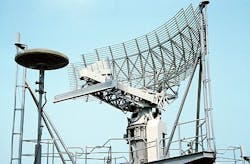Navy looks to Communications & Power to repair and rebuild klystron tubes for shipboard radar
CRANE, Ind., 8 May 2013. U.S. Navy radar experts needed repairs and rebuilds for klystron traveling wave tubes for long-range radar systems on Navy surface warships. They found their solution from Communications & Power Industries LLC in Palo Alto, Calif.
Communications & Power won a $6.9 million contract Monday for evaluations, minor and major repairs, and rebuilds of the klystron traveling wave tubes on the Raytheon AN/SPS-49 two-dimensional, long range air search radar on surface warships such as Perry-class frigates and Ticonderoga-class cruisers.
The klystron traveling wave tube is part of the AN/SPS-49 air search radar that detects and tracks airborne objects within range of the shipboard radar, Navy officials say. These devices also are part of electronic warfare systems.
A klystron is a specialized linear-beam vacuum tube that functions as an amplifier for high frequencies, from UHF radio frequencies up into the microwave range. Low-power klystrons are used as local oscillators in superheterodyne radar receivers.
Klystron amplifiers, as opposed to magnetron amplifier coherently amplifies a reference signal so its output may be controlled precisely in amplitude, frequency, and phase.
Klystrons amplify RF signals by converting the kinetic energy in a DC electron beam into RF power. A thermionic cathode produces a beam of electrons. The beam accelerates by high-voltage electrodes and passes through an input cavity resonator. RF energy feeds into the input cavity at its resonant frequency to produce a voltage that acts on the electron beam.
Klystrons can produce far higher microwave power outputs than solid state microwave devices. They are used in radar, satellite, and wideband high-power communications, medicine, and high-energy particle physics.
The AN/SPS-49 operates in the 851-to-942 MHz, or L- band, and has a range of 256 nautical miles. Its antenna rotates at six revolutions per minute in long range mode or 12 rotations per minute in short-range mode to defend against incoming missiles. The output stage of the transmitter uses a two-cavity klystron amplifier.
Communications & Power will do the work in Palo Alto, Calif., and should be finished by May 2018. Awarding the contract were officials of the Naval Surface Warfare Center in Crane, Ind.
For more information contact Communications & Power Industries online at www.cpii.com, or the Naval Surface Warfare Center Crane at www.navsea.navy.mil/nswc/crane.

